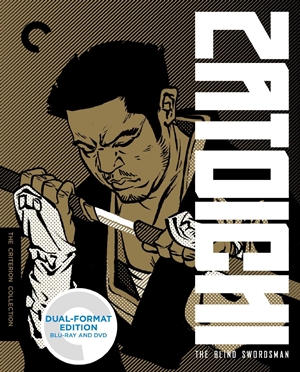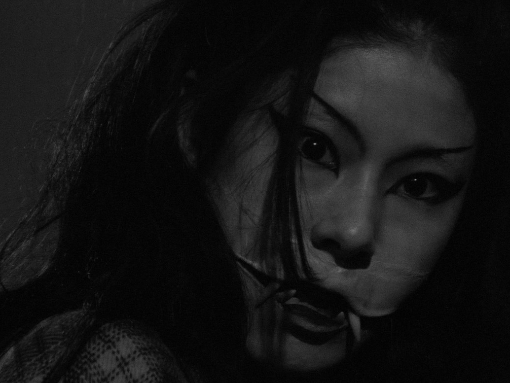Zatoichi: The Blind Swordsman

See more details, packaging, or compare
Synopsis
The colossally popular Zatoichi films make up the longest-running action series in Japanese history and created one of the screen's great heroes: an itinerant blind masseur who also happens to be a lightning-fast swordsman. As this iconic figure, the charismatic and earthy Shintaro Katsu became an instant superstar, lending a larger-than-life presence to the thrilling adventures of a man who lives staunchly by a code of honor and delivers justice in every town and village he enters. The films that feature him are variously pulse-pounding, hilarious, stirring, and completely off-the-wall. This deluxe set features the string of twenty-five Zatoichi films made between 1962 and 1973, collected in one package for the first time.
Picture 8/10
Criterion delivers the first 25-films of the Zatoichi series (together for the first time ever on home video in North America) on DVD and Blu-ray in this massive 27-disc box set. The final 1989 film, Zatoichi the Blind Swordsman is missing, possibly due to rights issues, as is the television series. All of the films are presented in their original aspect ratios of about 2.35:1 across nine dual-layer Blu-rays and 17 single and dual-layer DVDs (the 18th DVD is devoted solely to supplements.) The Blu-rays present the films in new high-definition 1080p/24hz transfers while the standard-definition transfers on the DVDs have been enhanced for widescreen televisions. Available film titles and disc specifications are listed in the Supplement section of this review.
I considered covering each film individually but as I wrote it up I realized that it would be a bit repetitive. As a whole most of the films are of the same quality, with a few stand outs for good reasons, and a handful for not-so-great reasons, which I will try to pinpoint here. All told, Criterion has done a spectacular job in delivering these films. The digital transfers themselves are all solid and deliver consistently clean, filmic presentations. Where it becomes iffy is in the condition of the source materials, the quality of which can vary wildly between each film.
All of the films show at least some general wear and tear, including some bits of debris, minor scratches, and mild stains. But a number of films still have some heavily damaged frames, with a couple of large splices or scratches jumping up, all of which are rather jarring since there’s very little damage elsewhere. Zatoichi the Outlaw is a bit of a mess itself, looking to come from a mix of different sources, later generation dupes in places, presenting a washed out look with little detail (in comparison to the other films,) blooming colours around some edges in many places, and a fair amount of damage. It also looks to have a heavy dose of red. Some of the colour films later in the run, like Zatoichi Meets Yojimbo, present colours that look a little over-saturated, and the last few films in the set also look blown out a bit.
Getting past all of that most of the films are in great shape and the transfers themselves leave little to complain about. Definition is sharp, with a high level of detail and a great sense of depth in some cases, at least when the source allows (I thought Zatoichi’s Flashing Sword, Zatoichi and the Doomed Man and Zatoichi and the Chess Expert all delivered a staggering amount of detail in their respective transfers.) The black and white films, The Tale of Zatoichi and The Tale of Zatoichi Continues, may have had their contrast boosted a bit but do deliver distinguishable gray levels and decent blacks. I didn’t detect any unnatural digital artifacts throughout any of the films and compression isn’t an issue on the Blu-rays, despite the fact three films have been placed on each Blu-ray disc.
Spot checking the DVDs they mostly share the same pros and cons as the Blu-rays but compression is, as expected, heavier and more noticeable. Halos are also a bit of an issue. Otherwise its clear the same masters were used.
Despite a few hiccups and issues with the source materials the transfers themselves are all very good, delivering as filmic a look as possible with each film.















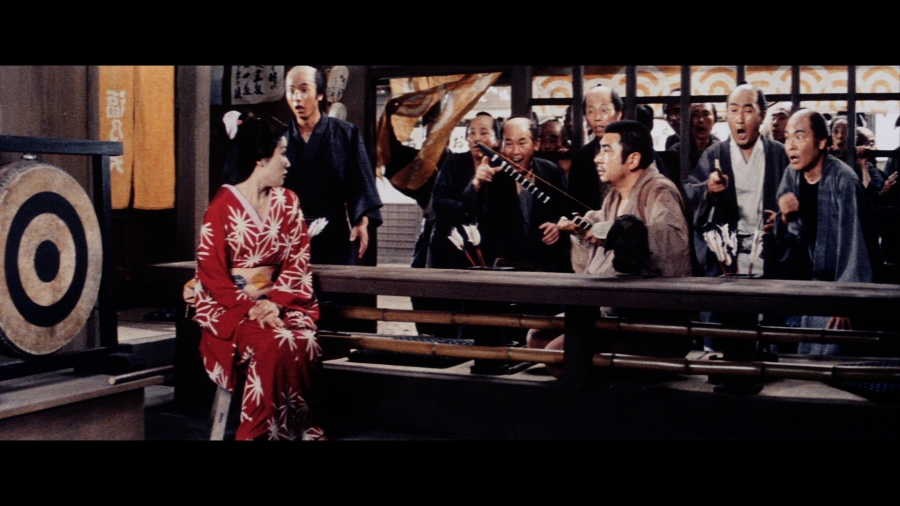







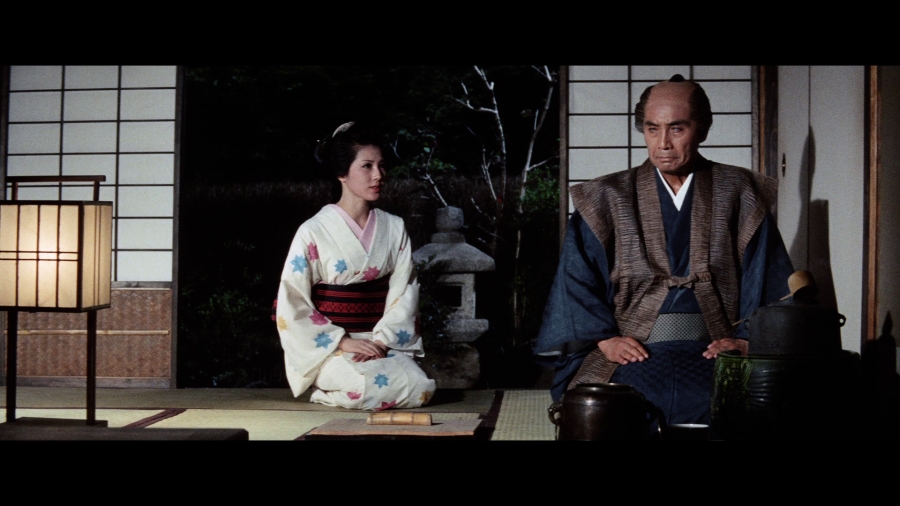
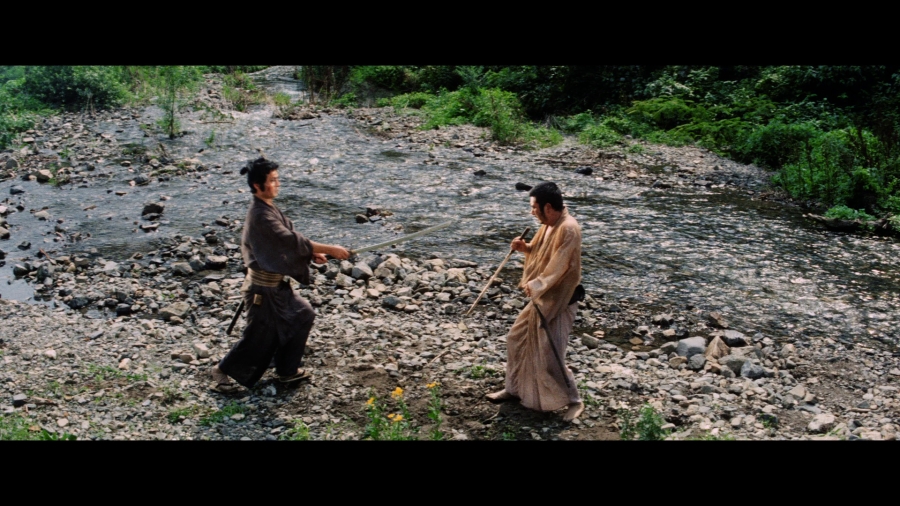

























Audio 6/10
All 25 films present lossless linear PCM mono tracks and they’re all of about the same quality. Dialogue sounds clear and the tracks have been restored nicely: not once throughout any of the films do I recall any hissing, cracks, or pops. Unfortunately the music in all of the films comes off edgy and distorted, irritating even at times. The tracks are also flat and lack any fidelity.
These issues have nothing to do with the transfers themselves, however. They’ve been restored and cleaned up nicely, but the source materials are held back by a mix of age and how they were originally recorded.
Extras 7/10
For what is such a massive release there is surprisingly little in the way of supplemental material. But in all honesty, after going through 25 films and admiring all the love and care Criterion put into this release as whole, I actually wasn’t too concerned. Criterion keeps the supplements short and sweet, and manage to offer some interesting insights into the series.
The films are spread out over the 9 Blu-ray discs, with 3 on the first 8 discs and then 1 on the 9th disc. The 9th disc also contains the supplements. For the DVDs, the films are spread out over the first 17 discs and the supplements are (inexplicably) spread out over the 17th and 18th discs, both of which are dual-layer (it’s odd only because all of the supplements could have fit on a single dual-layer disc.) The films and supplements are spread out as follows:
-
Blu-rays (all dual-layer discs):
- Disc 1: The Tale of Zatoichi, The Tale of Zatoichi Continues, and New Tale of Zatoichi
- Disc 2: Zatoichi the Fugitive, Zatoichi on the Road, and Zatoichi and the Chest of Gold
- Disc 3: Zatoichi’s Flashing Sword; Fight, Zatoichi, Fight; and Adventures of Zatoichi
- Disc 4: Zatoichi’s Revenge, Zatoichi and the Doomed Man, and Zatoichi and the Chess Expert
- Disc 5: Zatoichi’s Vengeance, Zatoichi’s Pilgrimage, and Zatoichi’s Cane Sword
- Disc 6: Zatoichi the Outlaw, Zatoichi Challenged, and Zatoichi and the Fugitives
- Disc 7: Samaritan Zatoichi, Zatoichi Meets Yojimbo, and Zatoichi Goes to the Fire Festival
- Disc 8: Zatoichi Meets the One-Armed Swordsman, Zatoichi at Large, and Zatoichi in Desperation
- Disc 9: Zatoichi’s Conspiracy and all supplemental material
-
DVDs
- Disc 1 (dual-layer): The Tale of Zatoichi and The Tale of Zatoichi Continues
- Disc 2 (single-layer): New Tale of Zatoichi
- Disc 3 (dual-layer): Zatoichi the Fugitive and Zatoichi on the Road
- Disc 4 (single-layer): Zatoichi and the Chest of Gold
- Disc 5 (dual-layer): Zatoichi’s Flashing Sword and Fight, Zatoichi, Fight
- Disc 6 (single-layer): Adventures of Zatoichi
- Disc 7 (dual-layer): Zatoichi’s Revenge and Zatoichi and the Doomed Man
- Disc 8 (single-layer): Zatoichi and the Chess Expert
- Disc 9 (dual-layer): Zatoichi’s Vengeance and Zatoichi’s Pilgrimage
- Disc 10 (single-layer): Zatoichi’s Cane Sword
- Disc 11 (single-layer): Zatoichi the Outlaw
- Disc 12 (dual-layer): Zatoichi Challenged and Zatoichi and the Fugitives
- Disc 13 (dual-layer): Samaritan Zatoichi and Zatoichi Meets Yojimbo
- Disc 14 (single-layer): Zatoichi Goes to the Fire Festival
- Disc 15 (dual-layer): Zatoichi Meets the One-Armed Swordsman and Zatoichi at Large
- Disc 16 (single-layer): Zatoichi in Desperation
- Disc 17 (dual-layer): Zatoichi’s Conspiracy and The Blind Swordsman documentary accompanied by interview with its director, John Nathan
- Disc 18 (dual-layer): Interview with Tony Rayns; theatrical trailers for all 25 films in the set
The first feature is a 1978 television documentary called The Blind Swordsman, the second episode from a 3-part series called The Japanese directed by John Nathan. The 58-minute presentation follows around Zatoichi star Shintaro Katsu on and off the set of an episode he’s directing for the third season of Zatoichi television series. On set we see him at work, paying a painstaking amount of detail to everything and coming down a bit hard on some of his cast and crew. We also get to witness Katsu out on the town, hitting the night clubs, hitting on women, drinking, showing off, and so on. We get some lively footage of the man outside of work, but the footage on the set shows a man focused and determined to bring out his vision.
It’s a rather engaging episode and I can’t say I was surprised by some of the things its director John Nathan had to say about making it in accompanying interview. Shooting the material off set proved to be an exhausting experience, even sending some crew members to the hospital, and Katsu was a rather wild man who liked to drink and stir up trouble (like hitting on the wife of a wrestler.) But Nathan talks about Katsu as an artist, saying that while he was “macho” and a “very Japanese fella” he was a delicate artist. He talks about his early career and the appeal of his Zatoichi character, and shares stories about the man. Both the interview and documentary offer a rather fascinating look at Katsu. The interview runs 17-minutes.
Serialized Success is a 27-minute interview with Tony Rayns who gives a brief history lesson on the Zatoichi films. He talks about the popularity of Japanese serials at the time (television wasn’t as popular as it was in North America) and then Katsu’s early work and how his role as a blind man in one film led to Zatoichi. He explains how the character of Zatoichi and his “codes” appealed to Japanese audiences who were thrilled with how he fought to protect the hardworking people (farmers, business owners) from the corrupt and greedy higher-ups. He nicely examines how Katsu built up the character through each film and covers how the actor gained more control over the films, which proved important when the original production company, Daiei, started facing financial troubles (Toho would eventually come in.) It’s an excellent primer for those new to the series.
The disc supplements then close with theatrical trailers for all 25 films on the set.
This impressive (and large) box set then includes a hardbound 95-page book, featuring an essay by Geoffrey O’Brien that covers the series extensively. Chris D. then provides breakdowns for each film in the set, which are all accompanied by illustrations by various artists. Criterion then includes the original short (very short) story “The Tale of Zatoichi” which presents the blueprint for the character and a few other characters.
The set of course misses obvious features like more material on the television series, the final film, Zatoichi the Blind Swordsman, or even the 2003 remake/reimagining, but it’s forgivable. We do get some strong material as it is and after 25 films I admittedly wasn’t aching to go through an endless amount of material (I’m actually thankful there were no commentaries to be found here.)
Closing
This is a gorgeous set, lovingly put together by Criterion. Though source materials vary between films the high-definition transfers themselves are all very strong. Throw in a few strong supplements and wrap it all up in a beautiful box and you have what is easily one of the best releases of the year.
